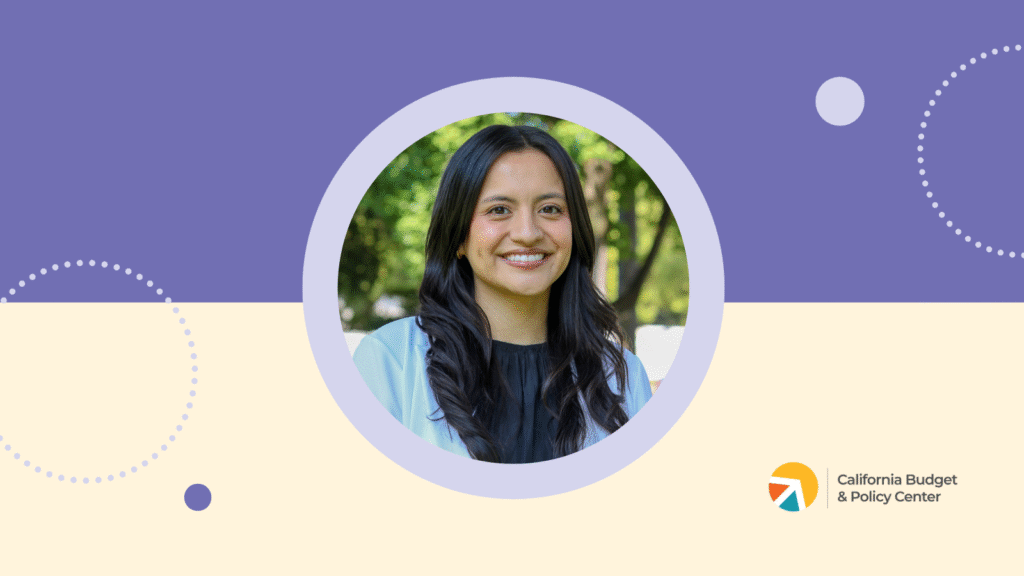The Budget Center communications team sat down with Ines Rosales (she/her), Outreach Associate at the Budget Center, who cultivates relationships with key influencers across California.
This Q&A series is your chance to get to know our team, their areas of expertise, and how their work at the Budget Center supports policy change in California. In this conversation, we’ll explore Ines’s approach to building meaningful partnerships and her passion for uplifting community voices through the Budget Power Project (BPP).
This interview was edited by Kat Petsalis, Communications Strategist at the Budget Center.
Can you tell us about your role at the Budget Center?
Absolutely! So, as an Outreach Associate, my main focus is to expand and cultivate relationships with key influencers across California. That includes not just elected officials, but also advocates, grassroots organizations, community leaders — basically anyone whose partnership can help us shape better policies.
A big part of my work is also supporting the Budget Power Project, which is about increasing the budget advocacy capacity of grassroots organizations and community-based groups across the state. So, my role is very relationship-driven — thinking strategically about where we need to build connections and how we can support communities in navigating budget processes to boost equity through public spending.
What inspired your interest in outreach, specifically within public policy? Has this always been a career path you envisioned for yourself?
Funny enough, my introduction to advocacy started in high school. I was part of a youth leadership program in Tulare County, where I grew up, and we took a trip to Sacramento for a lobbying day. That experience was my introduction to advocacy — realizing that you could speak up for your community’s needs and have a say in policymaking. From there, that set me on a path to pursue political science in college, with the goal of entering the advocacy space.
Since then, my entire professional career has been in the nonprofit and advocacy world. Before joining the Budget Center, I worked for organizations focused on child welfare and K-12 education reform. What I found in those roles was that the part of advocacy work that truly energized me was relationship building — figuring out how to create relationships with partners to reach shared goals, learning who could amplify our message, and who needed to be at the table to help move a campaign forward.
That’s ultimately what led me to the Budget Center. Even though we’re not an advocacy organization in the traditional sense, the heart of my work — building relationships and thinking strategically about partnerships — remains the same. It’s just a different lens on how we engage and support partners to influence policy decisions.
Can you share more about your experience being part of the Budget Power Project?
Oh gosh, where do I begin? I love the Budget Power Project — it’s honestly one of my favorite parts of my job. BPP is all about centering community voices in budget decisions. The project was designed to intentionally include organizations representing communities that have historically been excluded from public investments.
It aligns so much with my personal belief that people impacted by policies should be directly involved in shaping them. Through BPP, we work with grassroots leaders across different regions of California, and it’s incredible to see how priorities vary from place to place. What’s urgent in San Diego might be different from the Central Valley, for example. But what’s consistent is that these community leaders know best what their communities need. That’s the heart of BPP, and it’s what makes the work so meaningful for me.
What’s something exciting you’re currently working on?
Right now, I’m working on organizing a legislative briefing for this month, which I’m really excited about. It’s an opportunity to engage directly with legislative staff and elected officials — not just sharing the impacts of the federal budget bill, but also laying out concrete actions state leaders can take to protect Californians and learning what questions they have.
It feels like a more direct way of supporting Californians through public policy, which is thrilling. We’re not just presenting to state leaders; we’re fostering a conversation about solutions and advocating for proactive steps like raising revenue. It’s a chance to be very explicit about the actions we want to see, and I’m looking forward to that dialogue.
What’s one thing you can’t get through the workday without?
Oh, I definitely can’t get through the day without petting my little Chia, my dog. She doesn’t hang out much in my office, so I go find her in the living room. It’s a nice reset in my day!
How do you like to spend your time outside of work?
I’ve always been intentional about filling my social calendar, especially lately. I love my people — my friends and family — and I’m really lucky to have long-standing relationships from childhood, college, and beyond. I love making plans, whether it’s going to a movie, grabbing breakfast, or just hanging at home. Being around my people really recharges me, and I love nurturing relationships, which is kind of a theme for me in work and life.




